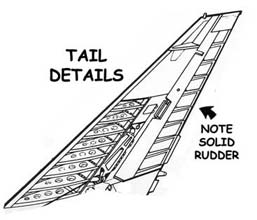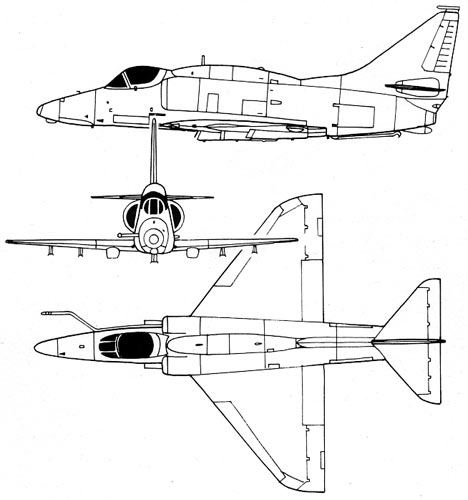



A4 Skyhawk - $$5.95
Includes a Blue Angel version, entire team set of tail markings, and little yellow truck Wow. The Douglas A-4 Skyhawk is a carrier-capable ground-attack aircraft designed for the United States Navy and U.S. Marine Corps. The "Skyhawk" was originally designated the A4D under the US Navy's pre-1962 designation system.
The McDonnell Douglas A4 Skyhawk
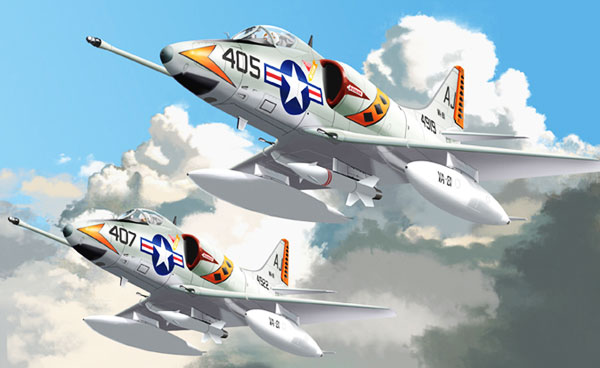
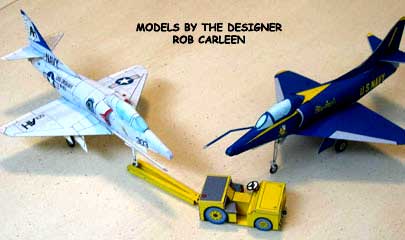 Little tractor not included, sorry |
Hundreds of Skyhawks served aboard carriers, many served with the US Marine Corps and with Argentina,
Australia, Israel. New Zealand and Singapore.
Folder includes the adorable tow truck ..Another great model by Rob Carleen.
Hot Rod Beats Expectations
Most expert opinion in the US Navy refused to believe the claim of Ed Heinemann, chief engineer of what was then Douglas El Segundo, that he could build a jet attack bomber weighing half the 30,000 lb specified by the Navy. The first Skyhawk, nicknamed "Heinemann's Hot Rod", not only flew but gained a world record by flying a 500 km circuit at over 695 mph.
The wing was made in a single unit, forming an integral fuel tank
and so small in wing span that folding for storage wasn't even necessary.
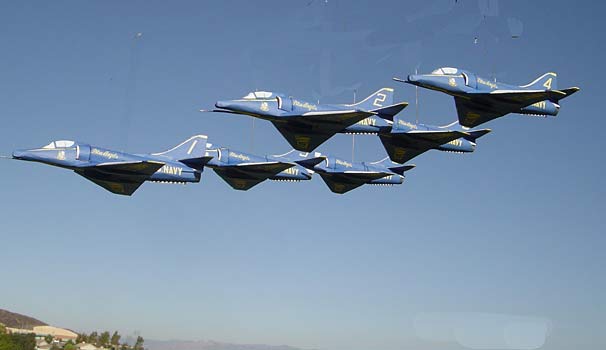 Here's a couple of blue sky BLUE ANGEL photos. My next FG project will be the Fokker tri plane dog fighting the Sopwith camel. Don (Don's flight touched up with Photoshop).. |
|
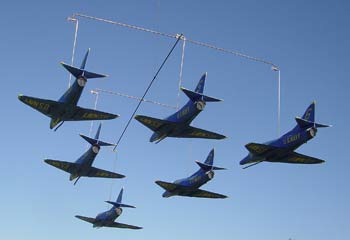 |
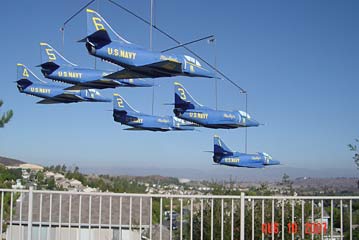 |
| Don Masters sent in these photos of his McDonnell Douglas A4 Skyhawk Blue Angel flight just off his deck in Santa Clarita, Ca. He soldered stiff wire into the mobile so the planes held formation. Thanks Don | |
McDonnell Douglas A- 4 Skyhawk

This marvelous little airplane might or might not be the finest ever built, but in its ability to beat the customer's specification it has no equal. Its designer, Ed Heinemann, went to work in 1952 on a US Navy specification calling for a carrier-based attack bomber capable of carrying heavy loads, The aircraft was to have a maximum weight of 30,000lb and be capable of speeds up to 495mph. When Heinemann, who was then chief engineer of the Douglas factory at El Segundo in California, came up with his design for an aircraft capable of fulfilling all of the Navy's requirements yet weighing less than half the specified maximum weight - only 11,200 lb - nobody believed him, because it just wasn't possible. But it was.
Heinemann had designed an astonishingly small aeroplane with wide but
very short wings, so short indeed that folding for stowage below decks
was unnecessary. This in turn made it easier to design the whole main plane
from wing-tip to wing-tip with one-piece skins enclosing integral fuel
tanks occupying almost the whole interior. During the planning stages,
these and many other radical innovations aroused serious doubts in the
US Navy hierarchy, but the skeptics were in for a tremendous surprise.
When the prototype XA4D- I took to the air on 22 June 1954, it not only
achieved the asked-for speed, but far exceeded the requirement, and the
aircraft went on, not much later, to set a new world record for circuit-flying
of 695mph, a speed which bettered the original specification by an incredible
200mph. The engine was the Wright J65, the British AS Sapphire built under
licence.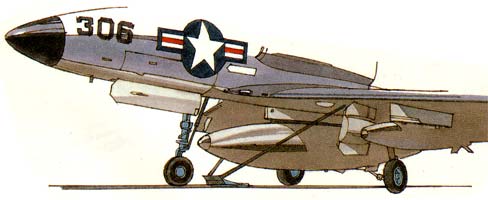
Once over their shock, the Navy chiefs hastily up-rated their performance
requirements and delivery to squadrons of the much-revised Skyhawk A4D-1.
Production began in October 1956. Known to its design team and
test pilots as 'Heinemann's Hot Rod', the aeroplane now acquired another
appellation: US Navy and Marine flyers called their new aircraft the 'Scooter'.
They loved it. It behaved so well in the air, with instruments and controls all so readily to hand that one pilot new to the Skyhawk said 'It was like making the transition from driving the station wagon to driving a sports car... and when you started to do rolls and other aerobatics, it was almost as if you were outside of the airplane and doing it all yourself' The Skyhawk was especially good for carrier touchdowns at sea. Its instant responsiveness was a great advantage and, once altitude and airspeed were under control, the aircraft would fly at a constant rate of descent all the way down onto the carrier's deck.
Later versions were hardly deserving of the affectionate name 'Scooter', because Navy demands for more and heavier armaments, and an ever-increasing range, necessitated the addition of a flight-refueling probe and strengthening of the airframe to absorb the thrust from Pratt & Whitney's more powerful J-52 engine, to enable gross weight to be increased to almost the originally specified 30,000lb. But the ratio of aircraft empty weight to carrying capacity remained near-constant, and these later Skyhawks were able to carry approximately double the burden originally required. Modifications carried out in the late1950s increased the weapon load to 9155 lb, almost equal to the weight of the aircraft when 'clean'.
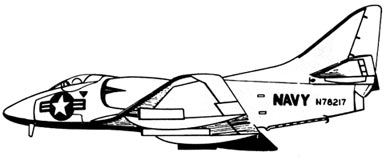
From 1962 the A4D designation became A-4 and soon the A-4F introduced
a 'camel hump' on the fuselage aft of the cockpit to house extra avionics,
which at first included guidance for Bull pup missiles. The A-4F was the
last Skyhawk attack version designed and built especially for the US Navy.
It had better pilot protection from ground fire, a more advanced ejector seat, and lift spoilers for a shorter landing run. Most subsequent single-seat variations were built primarily for delivery to the US Marines, though the lightweight TA-4J two-seater was the Navy's main air-combat trainer.
Coming far too late for use in the Korean War, introduction of the A-4Es
and A-4Fs was nevertheless fortuitous. The conflict in South East Asia
was rapidly gathering momentum, and these improved Skyhawks served alongside
the A-6 and A-7 as the most important attack aircraft flown by the US
Navy and Marines. Operating from carriers and from land bases, they flew
many thousands of ground-attack missions destroying a wide variety of
targets including the SA-2 (SAM) missile sites.
By the mid- 1960s the A-4Fs and A-4Cs had been endowed with a fearsome collection of weapons. In view of all this, it came as a great disappointment to Douglas Aircraft when in 1964 the US Navy decided to switch from Skyhawks to a newer aircraft, bought with great urgency, which materialized as the larger A-7 Corsair. However, the US Marines remained loyal and, when they declined to follow the Navy's lead, the A-4M Skyhawk II was specially developed to cater for the Marine Corps' particular requirement, and provided an important advance in the Skyhawk's performance. The new J52-P408 engine generated 20 per cent more thrust and managed at the same time almost to eliminate the tell-tale smoke trail left by the previous J52-powered A-4 versions. The aircraft has gone on to serve the Marines well, and has plenty of life left yet.

The first Skyhawks delivered to Israel - and put immediately into active service - were slight variations of the A-4E. Re-designated the A-4H (H for Hebrew), the aircraft introduced small changes in configuration, most notably a larger-area square-tipped fin. The aeroplane was fitted with powerful twin 30mm DEFA cannon instead of the normal US Navy 20mm weapons, and some of these aircraft were modified in 1970 with the 'camel hump' avionics fairing which was first seen in the A-4H.
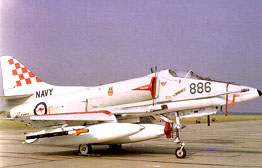
So, the Skyhawk remained extremely popular with the pilots of many other air forces including, among others, Indonesia, Brazil, Kuwait, New Zealand, Malaysia and Singapore (whose trainers have two bubble canopies). Not least, as far as Britain is concerned, came Argentina. In the 1982 conflict over the Falkland Islands - 30 years after the aircraft was first designed the Argentine Air Force and Navy used Skyhawks to sink British ships.
Heinemann's 'bantam bomber' was a a potent weapon. Originally its production was planned to last from 1954 to 1958 or 1959. Nobody thought that the original Douglas line, moved to Long Beach, would go on turning out new Skyhawks until 1980!
"Both these A4s I modeled can be seen at the National Museum of Naval Aviation in Pensacola.
They've been real helpful to me, even crawling around with the end of a tape measure to
help me get critical measurements." Rob Carleen
Rob's comments..
Fuselage--I managed to get it down to
two pieces. The first assembly attempts failed, as the fuselage didn't
have enough structure to hold shape and allow the wing to be glued accurately
to the fuselage. The little stiffener box solved that problem. The assembly
is still tricky--although it doesn't appear so. The key is to glue the
fuselage sections to the wing at the bottom, rather than to each other
first. The box also helps to properly shape the nose
section prior to fitting the intakes.
Wing--it's one piece--two folds. The wings between the
two models have slightly different wingtips, as do the prototypes. There's
no center section to put dihedral information, as it glues directly to
the fuselage bottom.
.
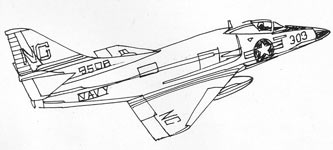 Landing gear--I put the creases where the gear folds double perpendicular to the grain
instead of parallel. It's a relatively slender gear (although I fattened
it up a bit for strength). When I did it the latter way, it was difficult
to fold it around a sliver of toothpick--this way is easier. I did not
make a tread section for the nose tire. The tire is very narrow and slipping
a bit of filler between the wheel halves, or just leaving it flat--seems
to look just fine.
Landing gear--I put the creases where the gear folds double perpendicular to the grain
instead of parallel. It's a relatively slender gear (although I fattened
it up a bit for strength). When I did it the latter way, it was difficult
to fold it around a sliver of toothpick--this way is easier. I did not
make a tread section for the nose tire. The tire is very narrow and slipping
a bit of filler between the wheel halves, or just leaving it flat--seems
to look just fine.
I left the landing gear fairing's as a single piece, to
facilitate modeling gear up.It separates into there distinct sections for
gear down. IMHO--the landing gear is the most complex part of the model.
I photographed one of my built models and converted it into a drawing
to illustrate the gear, as the real thing is even more complicated ....visually.
(Mechanically it's an amazingly simple system).
Miscellaneous stuff- The fleet bird got a complete set of under wing pylons--the BA version
only got the centerline pylon (that's
the way they were). On the instruction sheet--I suggested sources for
tanks and such (the A7 and Cougar) and what adjustments were going to
be needed to properly scale them. IFR probe was straight on early E models
and bent on the F models--later retrofitted to the earlier planes. It
may not be anatomically correct--but I left the straight probe for both
because I like the looks better and if anyone is a rivet counter, it would
be simple to modify the existing probe. The BA had a few other distinguishing
parts, like a ladder tube where the port gun should be, and a small drag
chute canister under the tail. I've decided that they're not significant
enough to model---plus, they'd be awfully fiddly and small.
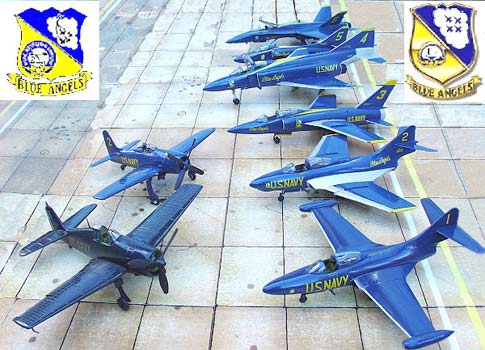
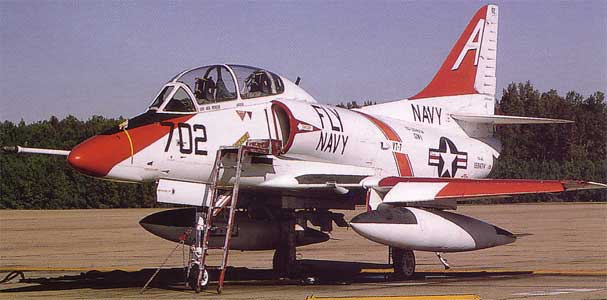
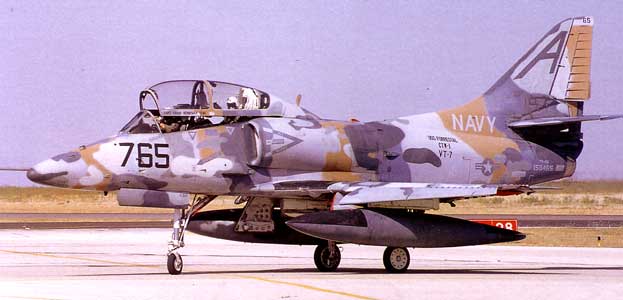
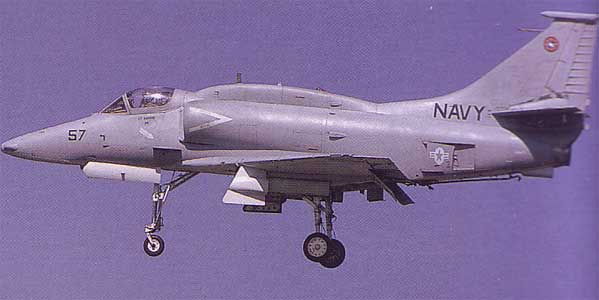
Information about the Aussie Version.. from our Modeln' Pal, Rick Thomson
Attached* please find my repaint of Rob's A-4. It is an A-4G of the Royal Australian
Navy as operated from HMAS Melbourne during the 70's. I hope it meets with your
approval, Both Rob and Jim are satisfied with it. I would be very pleased if
you would include it in the general release of the Skyhawk. A brief history
of the Down under Skyhawks and a shot of the A/C I have modeled on the deck
of HMAS Melbourne follows.
On October 26, 1965, the Royal Australian Navy (RAN) announced that it would procure 10 Skyhawks (8 single-seaters and two 2-seaters) for service aboard the HMAS Melbourne (ex HMS Majestic), in response to a perceived threat from Indonesia. They were designated A-4G and TA-4G respectively Douglas was authorized to proceed with the order on April 15, 1966. The first A-4G took off on its maiden flight on July 19, 1967, test pilot Jim Stegman being at the control. The A-4G was based on the A-4F, but was optimized for the air defense role.
It could mount Sidewinder air-to-air missiles under the four wing mounted pylons. The A-4G did retain a limited ground attack capability, but could not carry or deliver nuclear weapons. The pilot was provided with an Escapade 1C-3 zero-zero rocket ejector seat. Wing lift spoilers were installed above the flaps in the upper wing trailing edge, which were designed to improve crosswind landing performance. Nose wheel steering was provided to allow for better control during crosswind taxiing and during ramp or carrier deck maneuvering. The A-4G was powered by a Pratt & Whitney J52-P-8A engine, rated at 9300 lb.s.t. The aircraft could be equipped with an in flight refueling external buddy tank.
The two-seat Australian Skyhawk was designated TA-4G. The first TA-4G took off
on its maiden flight on July 21, 1967, test pilot Jim Stegman again being at
the controls. It retained all of the weapons capabilities of the single-seat
A-4G. The two crew members were provided with Escapade 1C-3 zero-zero rocket
ejector seats. Wing lift spoilers were installed above the flaps in the upper
wing trailing edge, which were designed to improve crosswind landing performance.
Nose wheel steering was provided to allow for better control during crosswind
taxiing. The TA-4G was also powered by the Pratt & Whitney J52-P-8A engine,
rated at 9300 lb.st. The aircraft could be equipped with an in flight refueling
external buddy tank.
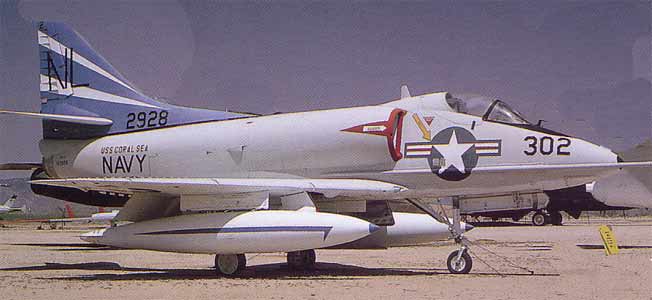
The eight A-4Gs were allocated Bureau Numbers of 154903/154910 during construction, and retained these numbers during RAN service but had the added prefix of N13--e.g. 154903 became N13-154903. The two TA-4Gs were N13-154911 and N13-154912. The first A-4G was officially turned over to the RAN in a ceremony at the Douglas Long Beach plant on July 26, 1967. The balance of the order was delivered to NAS North Island, California to be stored awaiting the arrival of the Melbourne for transportation back to Australia. While they waited for the delivery of the rest of their planes, RAN pilots trained at NAS Leemore in California on US Navy Skyhawks in order to provide crews with experience on the Skyhawk and to provide a cadre of instructors.
The Australian Skyhawks were assigned to two different squadrons. Number 805 Squadron (later VF-805) was the primary combat squadron, permanently based at Nowra but deployed on the deck of the Melbourne during operational cruises. Number 724 Squadron was the operational flying training school squadron for the A-4, and was shore-based at Nowra.
Because of the different center of gravity of the TA-4G, the two-seaters could not safely operate from the short deck of the Melbourne. They were assigned to the shore-based unit Number 724 Squadron at Nowra.
In 1970, an additional eight A-4Gs were obtained from US Navy A-4F fleet stocks, reconfigured, and delivered to the RAN. In 1971, an additional two TA-4Gs were obtained from US Navy TA-4F fleet stocks, reconfigured, and delivered to the RAN. They were N13-154647 and N13-154648. The two A-4Gs were allocated Bureau Numbers of 154911/154912 during construction, and retained these numbers during RAN service but had the added prefix of N13--e.g. 154911 became N13-154911.
Attrition of Skyhawks was heavy in RAN service, and no less than eleven were lost in accidents. In 1982, it was decided that the HMAS Melbourne would be taken out of service. When the Melbourne's operations were ended, VF-805's surviving aircraft were transferred to VC-724, which used them primarily for target towing.
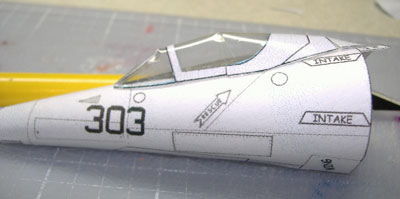 |
Clear Cabin McDonnell Douglas A-4 Skyhawk submitted by Bob Martin. |
Since being designed in 1952 the A-4 family has been improved by several thousand engineering changes, yet the basic airframe remains amazingly close to the original-even to the hastily schemed single-surface rudder with half-ribs on each side, introduced as a temporary measure in 1954! |
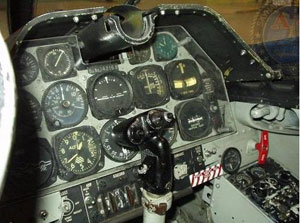 |
Cockpit of the A-4 Skyhawk. |
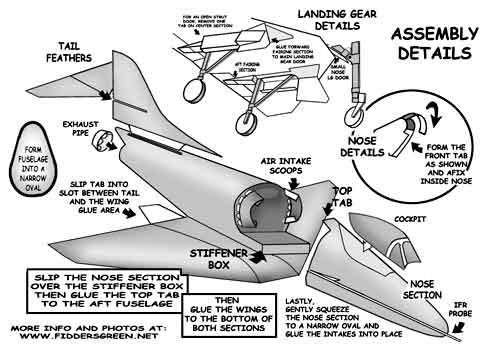
Specifications for the A-4 Skyhawk
|
Specifications Country of origin: USA. |
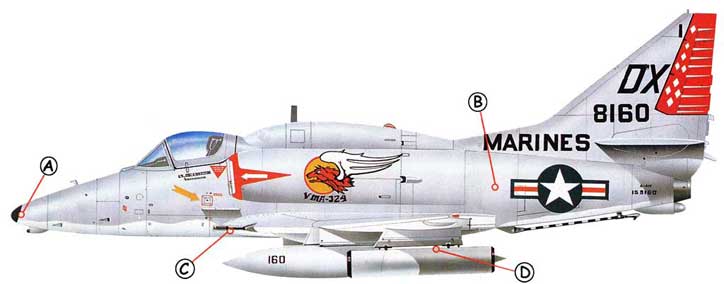 |
|||
| A: Upgraded A-4s often carry an attack radar, something not fitted to Skyhawks on the production line. | B: Skyhawk IIs have a later version of the Pratt & Whitney J52 turbojet engine. | C: Two 20-mm Mk 12 cannon were fitted to the A-4M. Singaporean A-4Ss have been equipped with two 30-mm Aden cannon, as fitted to such aircraft as the SEPECAT Jaguar and the BAe Sea Harrier. | D: In its day the Skyhawk could carry a substantial load of weapons. While this is modest by today's standards, upgraded A-4s can deliver much more modern and effective weapons than before. |
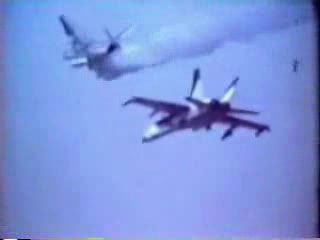 |
This A-4 Skyhawk was flying formation with a F-18 Hornet when disaster strikes. The F-18 '
looses' one of its bombs and the A-4 gets hit by it. The pilot was forced to eject and landed safely. |



